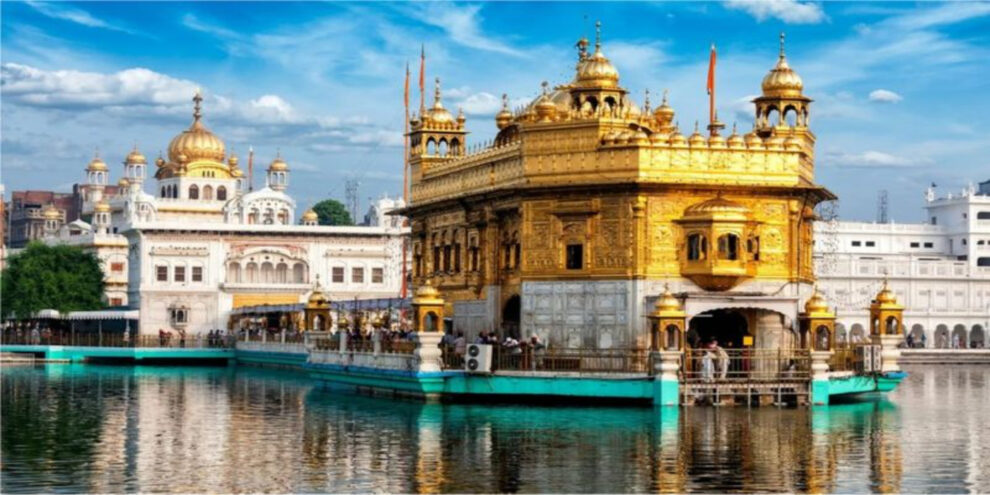Amritsar, a city of two million people in northern India, is known for many things: delicious food, historic old cities and the spectacular Golden Temple – the most important shrine of the Sikh religion.
However, what is most striking everywhere, from the temples to the people in the streets, is the sense of generosity that has to do with the founding of the city.
Amritsar was founded in the 16th Century by a Sikh guru and is located in the Punjab region, where Sikhism originates. The religion is known for its tradition of seva – voluntary acts done for others without expecting anything in return.
Many Sikhs around the world practice seva at the gurudwara (Sikh temple), often in the form of simple practices such as mopping floors, serving food, and maintaining order inside the temple. Others seva in their personal lives with generosity and charity.
In April 2021, as Covid-19 hit the lives of families across India, the Sikh community took to the field to deliver oxygen cylinders and medical supplies to those most in need.
“Seva means selfless service, and in Sikhism it is not just advice and guidance, but daily practice,” writes Jasreen Mayal Khanna in her book Seva: Sikh Wisdom for Living Well by Doing Good.
“Another name for seva is love,” said Abhinandan Chaudhary, 23, who has been doing seva with his family since he was eight.
“The common teaching is that one has to be so secretive and selfless, that if you seva with your left hand, not even your right hand can know about it.”
In a world that is increasingly individualistic and capitalistic, this is a refreshing way of life.
The spirit of generosity in Sikhism can be witnessed all over the world. During the Covid-19 lockdown, Sikh volunteers at a temple in England delivered thousands of meals daily to NHS staff, while Sikhs in various US cities cooked hundreds of thousands of free meals.
In crisis or emergency situations, Sikhs mobilize their full strength to help those in need, for example when Canada is hit by a hurricane or when New Zealand is hit by a typhoon.
However, in Amritsar, which is the center of the Sikh religion, seva is practiced at an even higher level.
It is common knowledge in India that no one sleeps hungry in Amritsar. That’s because there is always hot food at the Golden Temple, the most important shrine in the Sikh religion. It is available to anyone who wants it.
The Golden Temple houses a langar, the world’s largest communal kitchen, serving 100,000 people daily, seven days a week, free of charge.
Everyone can eat here, without discrimination, as long as they need shelter and food and food is available 24 hours a day.
New York-based Michelin-starred chef Vikas Khanna, who is distributing millions of meals across India during the Covid lockdown, said: “I was born and raised in Amritsar and we have a big soup kitchen where everyone can eat. The whole city can eat there. .”
“I just felt hungry when I was in New York, when I struggled from the bottom,” said Vikas.
Like all gurudwaras, the Golden Temple is well-run and highly disciplined by a fleet of volunteers, who serve basic, delicious dishes.
In one plate there are lentils, chapatti (flatbread), chickpea stew, and yoghurt.
People sat cross-legged on the floor in a large hall that could accommodate 200 people: men and women, young and old, rich and poor.
There is implicit choreography behind it that everyone seems to know. While some people asked for extra food, others left immediately after finishing their food.
After about 15 minutes, volunteers cleaned and prepared the hall for the next group. It’s a never-ending cycle of eating and serving.
From inside the temples to the streets, a sense of friendship, generosity and mutual assistance can be felt in Amritsar.
When we visited, smiling people always followed us and when we looked lost or confused someone would approach us and ask if they could help.
While walking around at night, passers-by told us to take good care of our bags in crowded areas.
When we arrived at Kesar da Dhaba, a famous restaurant with long lines, people were trying to make room at the large tables for us, even though they had to eat while seated tightly.
Friendship and sharing are everywhere, friendly glances and smiles, enough to get us invited to tea and chat about their lives.
“Growing up in Amritsar, I have the impression that I live in a big community,” says Rahat Sharma, who was born and raised here.
“When I was little I used to play hide and seek at the Golden Temple, where we all did seva. Everyone looked after each other. Sikhs and Hindus, the city’s two largest religions, live side by side peacefully, even though they often oppose each other politically.”
It’s no wonder then that this city is so full of energy because as much as Amritsar is a religious city, it is also alive.
His street food, with kulcha (flatbread) and chole (chickpea stew), phirni (rice pudding) in earthen pots, and big mugs of buttermilk, is the envy of all India.
The stunning though neglected old city, a labyrinth of narrow streets, junctions and small squares, is full of bazaars and seems lost in time.
However, amidst Amritsar’s generous and open character lies a dark contemporary history that has played a key role in shaping the city’s self-concept and dynamics – Sikhism as well.
As the second largest city in Punjab, Amritsar was often a hot spot for gatherings and protests during British rule.
One such incident turned brutal in 1919, when a British general gave orders to open fire on a peaceful gathering of people, which became known as the Jallianwala Bagh Massacre, which left 1,500 people dead.
In addition, when the British hurriedly left India in 1947, the violence that led to the Partition of India greatly affected Amritsar due to the city’s location so close to the newly created borders. (Due to this history, India’s first and only Partition Museum opened in Amritsar in 2017).
In 1984, Amritsar was once again the site of tragic events. The military operation ordered by Prime Minister Indira Gandhi involved the storming of the Golden Temple by military forces to flush out the separatists, the traumatic impact of which can be felt even today.
This led to Gandhi’s assassination by two of his Sikh bodyguards a few months later, and the massacre of thousands of innocent Sikhs across India in the following days.
It is important for Sikhs to preserve the memory of this event; The stories of Sikh martyrs are a big part of their cultural memory, even recited in their prayers, ardas.
“Yet these stories are not retold to incite hatred or seek revenge. Instead, it is our legacy as protectors that is emphasized,” Khanna wrote.
And that’s why it’s even more amazing that a community that has suffered so much collective trauma is still so generous and accepting of everyone. According to Khanna, these qualities are an integral part of being a Sikh.
“Guru Nanak (the founder of Sikhism) made seva a Sikh song… Sikhs simply choose to make selflessness a big part of their lives, inspired by the words as well as the deeds of their gurus.”
The Sikh tradition of receiving and welcoming people regardless of their religion or belief, is a testament to their generosity – as well as the city that groundes these sentiments in the best possible way.
In Amritsar, no matter how bleak and dark things get, the spirit of kindness, love and generosity always seems to prevail.

Source : BBC















